 |
 |
 |
by Peter Tyson In a word, yes. But that assertion, like saying we can predict the weather, bears significant caveats. Volcanologists can predict eruptions—if they have a thorough understanding of a volcano's eruptive history, if they can install the proper instrumentation on a volcano well in advance of an eruption, and if they can continuously monitor and adequately interpret data coming from that equipment. But even then, like their counterparts in meteorology, volcanologists can only offer probabilities that an event will occur; they can never be sure how severe a predicted eruption will be or, for that matter, whether it will even break the surface.
Still, under ideal conditions, volcanologists have recently met with a great
deal of success in foretelling eruptions. While they were caught off guard by
the exact timing and magnitude of the 1980 Mt. St. Helens eruption, for
example, their timely warnings of an impending blow prompted the U.S. Forest
Service to evacuate people from dangerous areas near the volcano. Though 57
people died in the eruption, perhaps 20,000 lives were saved, says Dr. William
Rose, a volcanologist at Michigan Technological University. Similarly, a USGS
SWAT team that rushed to the Philippines' Mt. Pinatubo in the spring of
1991 successfully augured the June eruption, leading to evacuations that saved
thousands if not tens of thousands of lives and millions of dollars worth of
military equipment at the nearby Clark Air Force Base.
They know when and how Kilauea will erupt because it does so frequently and
predictably, and because after decades of intensive study they know the volcano
inside and out. Learning as much as possible about a volcano's previous
behavior is the essential first step in anticipating future blows, just as
knowing a career criminal's record can help indicate what he might do next.
"There is no doubt that the eruptive history of a volcano is the main key for
long-term prediction," says Dr. Yuri Doubik, a Russian volcanologist who has
studied past eruptions on the Kamchatka Peninsula for 35 years. Such work
entails laboriously picking through the physical remains of previous eruptions.
And mapping such old lava flows, pyroclastic deposits, and other volcanic
debris distributed around a crater can reveal much about the timing, type,
direction, and magnitude of previous blows.
The Volcanologist's Toolkit When a volcano's eruptive history is known, researchers can more confidently turn to modern techniques to help them call the next eruption. The most valuable among these, volcanologists agree, is monitoring a volcano's seismicity—the frequency and distribution of underlying earthquakes. Use of the seismologist's tool in volcanology has come a long way since Frank Perret, one-time assistant to Thomas Edison, gleaned the frequency of the small shocks that continually shake Vesuvius's flanks by biting down on the metal frame of his bed, which was set in cement. Today sophisticated seismographs can register the magnitude, escalation, and epicenters of earthquakes that occur as magma moves beneath volcanoes. The more seismographs technicians deploy on a volcano, the more complete the picture they get of the mountain's plumbing.
While seismicity is the workhorse, monitoring ground deformation is another up-and-coming technique that allows three-dimensional mapping of what's occurring underground. Magma rising from the depths often pushes the skin of a volcano up and out, like a balloon filling with air. Sensitive tiltmeters and surveying instruments can measure and record the slightest changes, which help volcanologists determine, for example, roughly how deep a magma source is, how fast it is moving, and where on a volcano it might erupt. Such monitoring has helped scientists anticipate eruptions at Hawaii's Kilauea and Mauna Loa volcanoes, which deform in predictable ways and at predictable rates.
Measuring Vapors Such is the long-term hope as well for techniques to monitor volcanic gases. Magma deep underground lies under enormous pressure, which keeps vapors dissolved. But as magma rises toward the surface, the pressure eases and gases such as carbon dioxide and sulfur dioxide begin to bubble out of the liquid rock and into the air. Theoretically, changes in concentrations of CO2 and SO2 emitted by a volcano can be used to predict eruptions, as can the escalating output of gases in general. The USGS team that was sent to Pinatubo in the spring of 1991 successfully predicted the June eruption in part after watching SO2 levels shoot up to unprecedented levels of 16,500 tons per day.
Concurrently, Williams and others are working on infrared telescopes to
monitor concentrations of gases escaping from volcanic vents. Williams's
version is modeled after the correlation spectrometer, a device originally
developed in the 1970s to monitor SO2 and other toxic gases from
factory smokestacks. His prototype unit measures the amount of infrared light
absorbed by CO2 molecules, from which an estimate of CO2
concentrations in the air can be made. Dr. Kenneth McGee, a volcanologist at
the Cascades Volcano Observatory in Vancouver, Washington, is perfecting an
infrared spectrometer that he says will detect still other volcanic gases that
absorb infrared light, including hydrochloric acid gas, carbon monoxide,
methane, and water vapor.
While volcanologists feel confident that these ever-improving technologies will enable them to predict when an eruption is about to occur, they still cannot reliably estimate an impending eruption's size or exact nature. How large will the eruption be? Will it be explosive like Mt. St. Helens or effusive like Kilauea? Indeed, will it even open a vent in the surface? To be able to answer such questions, Tilling and USGS colleague Dr. Peter Lipman argued in a 1993 article in Nature for the need to develop "rugged, reliable real-time systems" to measure changes not only in seismicity, ground deformation, and gases, but also in gravitational and electromagnetic fields—in short, equipment to read the gamut of signals given out by a restless volcano. "There's no magic bullet in predicting volcanic eruptions," says Dr. Charles Connor, a volcanologist at the Southwest Research Institute in San Antonia, Texas. "The key thing is to cross-correlate as many different observations as possible." Tilling says volcanologists also need to get a better handle on the basic mechanisms behind precursory signals, such as the long-period earthquakes that often precede eruptions. Dr. Bernard Chouet, a VHP volcano seismologist, says these quakes provide a "direct window" into the magmatic fluid moving about beneath a restless volcano. "These earthquakes are like stress gauges that light up and reflect the pressurization going on below," he says. Careful monitoring of such natural gauges can help forecast eruptive activity. The USGS team that successfully predicted Pinatubo's burst did so in part by watching the build-up of long-period quakes.
Tilling, for one, is confident that such an apocalyptic blast will not come
unheralded. "No volcano is going to suddenly produce one of these humongous
eruptions without giving a lot of signals," he says. "But what will those
signals be?" Planning for Disaster | Resources | Teacher's Guide Transcript | Printable page | Site Map | Vesuvius Home Editor's Picks | Previous Sites | Join Us/E-mail | TV/Web Schedule About NOVA | Teachers | Site Map | Shop | Jobs | Search | To print PBS Online | NOVA Online | WGBH © | Updated November 2000 |
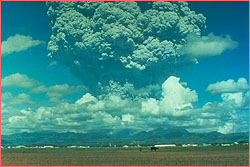 Eruption of Mt. Pinatubo,
Philippines, June 1991.
Eruption of Mt. Pinatubo,
Philippines, June 1991.
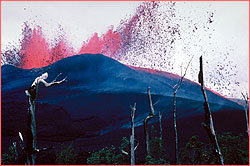 A Kilauea lava
fountain spews from Puu Oo vent on March 13, 1985.
A Kilauea lava
fountain spews from Puu Oo vent on March 13, 1985.
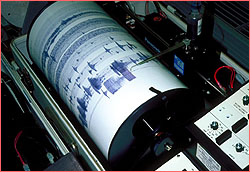 Close-up of a seismograph drum.
Close-up of a seismograph drum.
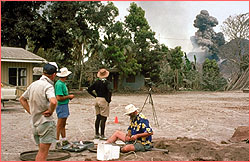 Tavurvur volcano erupts in the distance
as workers install a tiltmeter at Rabaul, Papua New Guinea, September
1994.
Tavurvur volcano erupts in the distance
as workers install a tiltmeter at Rabaul, Papua New Guinea, September
1994.
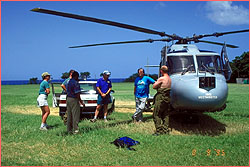 A USGS team prepares to fly a gas-measuring flight
at Montserrat, August 1995.
A USGS team prepares to fly a gas-measuring flight
at Montserrat, August 1995.
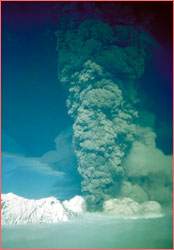 Alaska's Spurr volcano blows its top
on August 19, 1992.
Alaska's Spurr volcano blows its top
on August 19, 1992.
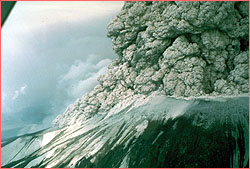 Mt. St. Helens erupting, May 18,
1980.
Mt. St. Helens erupting, May 18,
1980.
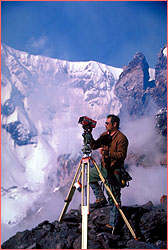 USGS Volcanologist Ken Yamashita surveys on the dome, Mt. St.
Helens, March 1986.
USGS Volcanologist Ken Yamashita surveys on the dome, Mt. St.
Helens, March 1986.